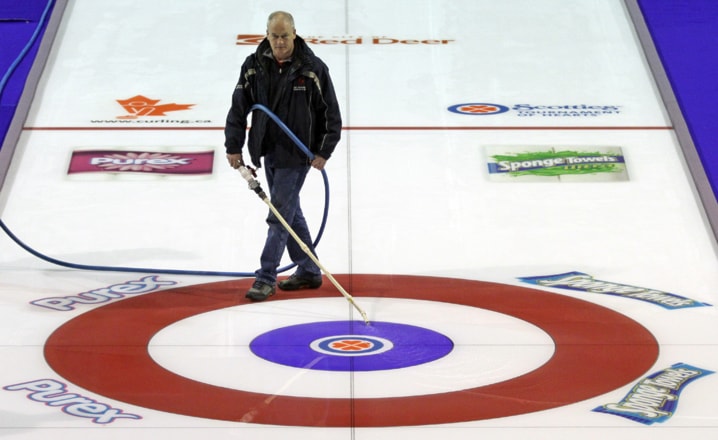They weren’t handing out medals for making curling rink ice at the Vancouver Olympics.
But if they did, it would have been a gold medal performance for ice technicians Dave Merklinger, Eric Montford and Hans Wuthrich.
Montford and Merklinger, who have teamed up again in Red Deer for the Scotties Tournament of Hearts, rank those 2010 Olympic sheets as among the best they’ve ever made.
“It turned out fantastic,” says Merklinger, 57, taking a break after painting the circles on the four sheets that will host the country’s top women curlers beginning today.
The Olympics gig carried “heavy-duty pressure” and a three-year commitment, which made the rave reviews all the sweeter.
Merklinger, from Lavington, near Vernon, B.C., and Winnipeg’s Montford have spent the last few days turning the Rebels’ home rink into four world-class curling sheets worthy of the sport’s best women.
Merklinger is bringing 43 year of ice making experience — 38 as a full-time professional — to the rink. Montford, 49, has been making ice for more than 30 years and is Merklinger’s assistant in Red Deer.
The pair are both national ice technicians for the Canadian Curling Association.
“Basically we’ve got to turn a hockey rink into a curling rink in not a whole lot of time,” Merklinger says.
“As you can see, we have a ton of volunteers here and you need ’em. A lot of them are ice technicians in their own right and they’re here to learn some tricks of the trade and advance their own ice-making skills.
“I think there’s 20 volunteers, just on the ice rink.”
Merklinger and Montford began work early Sunday afternoon. By noon Monday, he’d finished painting the circles and had the rest of the lines and logos completed by late evening.
The next few days were spent laying down water and pebbling, a technique that gives the ice texture with droplets of water.
There are many factors that have to be taken into account when trying to create the best possible surface. Outside and indoor air temperatures, humidity levels, the heat from lights and the crowd all must be factored in.
“I’ve been doing this for a long time so there’s a lot of anticipation,” he says.
Merklinger is familiar with the setup in Red Deer, having been the ice maker at the 2004 Scotties held here.
“I have to provide entertaining ice for the players that they feel confident on throwing with curl, that looks good on TV and looks good to spectators.
“Basically that’s my job — make them look good.”
Curlers, who can be very particular about their ice, rarely come away other than impressed.
“When they come here it’s quite a bit different than their curling clubs. For some teams, it takes a few games to get used to it, but after playing on it they go, ‘I never want to go back to my curling club. I want to keep playing on this stuff.’
“This is the show. They deserve good ice.”
Good ice maintains its consistency from start to finish so players aren’t faced with a surface that gets heavier or straightens out rocks.
While the tournament is underway, he monitors the compressors to ensure the ice temperature remains constant. Air circulation must also be maintained so the building doesn’t get too hot.
Merklinger, who is a competitive curler himself when he finds the time, threw his first stone as a 12-year-old in Winnipeg. He had moved to Trenton, Ont., when as a teenager he took his first stab at making ice under the tutelage of Shorty Jenkins, a legendary ice maker in curling circles.
“Just the love of the game basically,” he says when asked what drew him to ice making. “I had no aspirations of being a doctor or a lawyer. I could have been a plumber,” he adds with a chuckle, “but I took up ice making.”
Thirty years in Ottawa followed before he decided to see what the West was like and moved to New Westminster, B.C., in 2000, where he managed the rink for a number of years. He’s been managing and ice making at the Vernon Curling Club for the past four years.
His son Mike has followed him into the business and makes ice in Vancouver. A daughter teaches school in Ottawa.
The two ice-making Merklingers worked together at the Continental Cup in Langley, B.C., last month.
Merklinger said he typically takes on only two or three of the big events a year.
“You can’t do too many of these. They kill you. They do. They’re hard on your body because you’re going 16, 17, 18 hours a day and 16 days — it’s not easy.
“As much as there’s pressure on the players, there’s as much pressure on us as well.”
pcowley@www.reddeeradvocate.com
